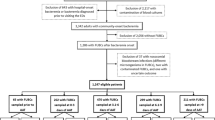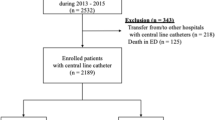Summary:
Catheter-related bloodstream infections are associated with recognized morbidity and mortality. Accurate diagnosis of such infections results in proper management of patients and in reducing unnecessary removal of catheters. We carried out a prospective study in a bone marrow transplant unit to assess the validity of a test based on the earlier positivity of central venous blood cultures in comparison with peripheral blood cultures for predicting catheter-related bacteremia. Between May 2002 and June 2004, 38 bloodstream infections with positive simultaneous central venous catheter and peripheral vein blood cultures were included. A total of 22 patients had catheter-related bacteremias and 16 had noncatheter-related bacteremias, using the catheter-tip culture/clinical criteria as the criterion standard to define catheter-related bacteremia. Differential time to positivity of 120 min or more was associated with 86% sensitivity and 87% specificity. In conclusion, differential time to positivity of 120 min or more is sensitive and specific for catheter-related bacteremia in hematopoietic stem cell transplant recipients who have nontunnelled short-term catheters.
This is a preview of subscription content, access via your institution
Access options
Subscribe to this journal
Receive 12 print issues and online access
$259.00 per year
only $21.58 per issue
Buy this article
- Purchase on Springer Link
- Instant access to full article PDF
Prices may be subject to local taxes which are calculated during checkout
Similar content being viewed by others
References
Maki DG, Mermel LA . Infections due to infusion therapy. In: Bennett JV, Brachman PS (eds). Hospital Infections. Lippincott-Raven: Philadelphia, 1998, pp 689–724.
Jarvis WR, Edwards JR, Culver DH et al. Nosocomial infection rates in adult and pediatric intensive care units in the United States. National nosocomial Infections Surveillance System. Am J Med 1991; 91: 185S–191S.
McGee DC, Gould MK . Preventing complications of central venous catheterization. N Engl J Med 2003; 348: 1123–1133.
Siegman-Igra Y, Anglim AM, Shapiro DE et al. Diagnosis of vascular catheter-related bloodstream infection: a meta-analysis. J Clin Microbiol 1997; 35: 928–936.
Sheretz RJ, Heard SO, Raad II . Diagnosis of triple-lumen catheter infection: comparison of roll plate, sonication, and flushing methodologies. J Clin Microbiol 1997; 35: 641–646.
Widmer AF, Nettleman M, Flint K, Wenzel RP . The clinical impact of culturing central venous catheters. A prospective study. Arch Intern Med 1992; 152: 1299–1302.
Fan ST, Teoh-Chan CH, Lau KF . Evaluation of central venous catheter sepsis by differential quantitative blood culture. Eur J Clin Microbiol Infect Dis 1989; 8: 142–144.
Capdevila JA, Planes AM, Palomar M et al. Value of differential quantitative blood cultures in the diagnosis of catheter-related sepsis. Eur J Clin Microbiol Infect Dis 1992; 11: 403–407.
Blot F, Schimdt E, Nitenberg G et al. Earlier positivity of central-venous versus peripheral-blood cultures is highly predictive of catheter-related sepsis. J Clin Microbiol 1998; 36: 105–109.
Blot F, Nitenberg G, Chachaty E et al. Diagnosis of catheter-related bacteraemia: a prospective comparison of the time to positivity of hub-blood versus peripheral-blood cultures. Lancet 1999; 354: 1071–1077.
Malgrange VB, Escande MC, Theobald S . Validity of earlier positivity of central venous blood cultures in comparison with peripheral blood cultures for diagnosing catheter-related bacteremia in cancer patients. J Clin Microbiol 2001; 39: 274–278.
Seifert H, Cornely O, Seggewiss K et al. Bloodstream infection in neutropenic cancer patients related to short-term nontunnelled catheters determined by quantitative blood cultures, differential time to positivity, and molecular epidemiological typing with pulsed-field gel electrophoresis. J Clin Microbiol 2003; 41: 118–123.
Gaur AH, Flynn PM, Giannini MA et al. Difference in time to detection: a simple method to differentiate catheter-related from non catheter-related bloodstream infection in immunocompromised pediatric patients. Clin Infect Dis 2003; 37: 469–475.
Raad I, Hanna HA, Alakech B et al. Differential time to positivity: a useful method for diagnosing catheter-related bloodstream infections. Ann Intern Med 2004; 140: 18–25.
Rijnders BJ, Verwaest C, Peetermans WE et al. Difference in time to positivity of hub-blood versus nonhub-blood cultures is not useful for the diagnosis of catheter-related bloodstream infection in critically ill patients. Crit Care Med 2001; 29: 1399–1403.
Seldinger SI . Catheter replacement of the needle in percutaneous arteriography: a new technique. Acta Radiol 1953; 39: 368–376.
Brun-Buisson C, Abrouk F, Legrand P et al. Diagnosis of central venous catheter-related sepsis. Arch Intern Med 1987; 147: 873–877.
Raad I, Bodey GP . Infectious complications of indwelling vascular catheters. Clin Infect Dis 1992; 15: 197–210.
Mermel LA, Farr BM, Sheretz RJ et al. Guidelines for the management of intravascular catheter-related infections. Clin Infect Dis 2001; 32: 1249–1272.
Krzywda EA, Andris DA, Edmiston CE, Quebbeman EJ . Treatment of Hickman catheter sepsis using antibiotic lock technique. Infect Control Hosp Epidemiol 1995; 16: 596–608.
Messing B, Man F, Colimon R et al. Antibiotic lock technique is an effective treatment of bacterial catheter related sepsis during parenteral nutrition. Clin Nutr 1990; 9: 220–227.
Author information
Authors and Affiliations
Corresponding author
Rights and permissions
About this article
Cite this article
Abdelkefi, A., Achour, W., Ben Othman, T. et al. Difference in time to positivity is useful for the diagnosis of catheter-related bloodstream infection in hematopoietic stem cell transplant recipients. Bone Marrow Transplant 35, 397–401 (2005). https://doi.org/10.1038/sj.bmt.1704773
Received:
Accepted:
Published:
Issue Date:
DOI: https://doi.org/10.1038/sj.bmt.1704773
Keywords
This article is cited by
-
Central venous catheter–related infections in hematology and oncology: 2020 updated guidelines on diagnosis, management, and prevention by the Infectious Diseases Working Party (AGIHO) of the German Society of Hematology and Medical Oncology (DGHO)
Annals of Hematology (2021)
-
Prävention von Infektionen, die von Gefäßkathetern ausgehen
Bundesgesundheitsblatt - Gesundheitsforschung - Gesundheitsschutz (2017)
-
Use of rapid diagnostic techniques in ICU patients with infections
BMC Infectious Diseases (2014)
-
Utility of surveillance blood cultures in patients undergoing hematopoietic stem cell transplantation
Antimicrobial Resistance and Infection Control (2014)
-
Infections sur cathéters : quoi de neuf ?
Réanimation (2013)



